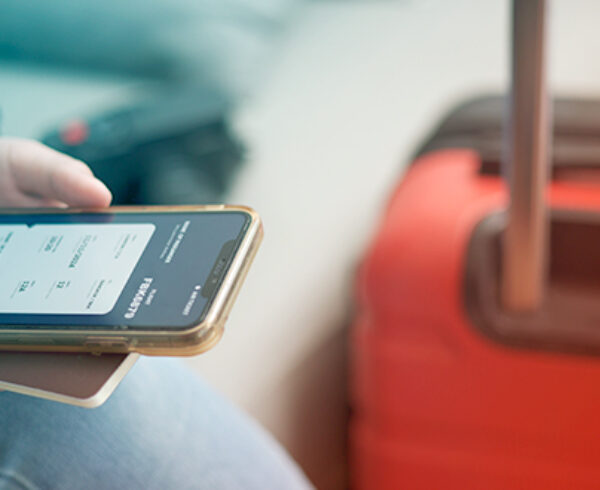When it comes to choosing travel by train vs plane, there’s a lot to consider: speed, convenience, price—and, of course, sustainability.
Depending on where you live in the world, your first instinct might be to take the train if the journey’s short enough. This is especially the case if you live in a region with ample rail infrastructure and lots of ground transportation options. However, if you live in a region where that’s not the case, taking the train for a business trip might not even cross your mind. Your first go-to is always air travel.
Regardless of first instinct, though, the ground transportation vs air travel debate needs a closer look. This is the case particularly as more and more organizations are reevaluating their business travel in an effort to make more sustainable business travel decisions. (And, honestly, train travel isn’t the best choice in every single situation).
Have you put off analyzing your travel decisions and whether or not it really makes sense for your Travelers to take a train vs plane for short-distance trips? There’s no better time than this month, as we approach Earth Day, April 22.
Here’s everything you need to think about for those shorter trips.

Train vs Plane: Price
In general, if you’re in a region where the train infrastructure is more robust, train travel will be more affordable. If you’re in a region where that’s not the case, train travel may be more expensive, but not always.
For example, an Amtrak trip between New York City and Philadelphia costs between $50 and $150. A flight between the two is about the same, on a budget airline.
As another example, if you’re in Europe, a train trip between Antwerp and Amsterdam will be under $100, but a flight will be much more expensive and inconvenient due to the lack of direct flights between the two destinations.
Train vs Plane: Sustainability
The answer to whether train or air travel is more sustainable is pretty obvious. However, to drive the point home, the Matador Network broke down the carbon footprints resulting from various popular travel routes, both if one were to take a train and if one were to fly. The differences are dramatic.
The publication found that, flying between New York and Los Angeles results in about 695 kilograms of Co2 per passenger. In contrast, the per-passenger carbon footprint of a train trip between the two cities equals about 119 kilograms of Co2. That’s a reduction of approximately 80%.
Flying between London and Paris generates 55 kilograms of Co2 per passengers. Traveling via train between the two generates 4.5 kilograms of Co2 per passenger.
Tokyo to Osaka? A flight generates 129 kilograms of Co2 per passenger. A train trip generates a mere 1 kilogram of Co2 per passenger.
Matador looked at a variety of similar routes, including Berlin to Paris, Barcelona to Paris, and Rome to Venice, but the outcome was always the same. Train travel is just more sustainable than air travel, by a long shot.

Train vs Plane: Convenience
While which option, train travel or a flight, will remain more affordable and more sustainable for your team will likely stay the same in most instances, that’s not the case with convenience. Which option is the most convenient will likely change with every single business trip. There are so many factors that will influence whether or not one option is more convenient than the other.
For example, where is your Traveler coming from and where is your Traveler going? We’re not just talking airport to airport or rail terminal to rail terminal. We’re talking door to door. Is your Traveler headed to a conference center that’s literally right next door to a train station, but an hour away from the nearest major air hub? Then train travel might be the best fit.
Do you have plenty of rail infrastructure in your city, but your Traveler is headed to meet with a client in a region that doesn’t have quite so much infrastructure, where they’ll need to change trains multiple times in order to make it to their final destination? Then you might consider flying.
Take Luggage Into Consideration
Another thing to consider? Luggage and any items needed for conferences and client meetings. Depending on the travel provider, you may find that rail is much more generous when it comes to amount of luggage you can bring with you. Amtrak, for example, allows two carry-on items and up to four checked bags.
Lastly in terms of convenience, if you’re worried about delays and interruptions, that’s yet another factor that will differ according to not just your individual circumstances, but also the individual trip. Trains and air travel are both impacted by labor strikes and weather, and what’s going on at the time of your travel will dictate to what extent factors like these influence your Travelers.

Train vs Plane: Time Required
Timing is likewise a concern. If your local airport is a major hub, the security lines will be longer and getting into and out of the airport will require more time. If your local airport is regional and small, you may be able to arrive at the airport just a mere 30 minutes before boarding begins. With train travel, though, you don’t really need to arrive in advance at all.
Of course, air travel is also faster than train travel. You can fly from Edinburgh to London on British Airways in under an hour and a half. The same train trip can take over six hours. How long do you want your Travelers to spend in transit? Is that valuable time that they could use in other ways?
Train vs Plane: Traveler Preference
Of course, when deciding which is the right option for you and your Travelers, it’s also worth considering Traveler preference. For some, train travel is far preferable to air travel, as it’s generally considered less stressful. For others, they want to get to their destination as quickly as possible, so may prefer air travel. Others also want to take advantage of the frequent flyer rewards and perks that come along with their frequent flyer status.
As is the case when making any decision related to Travelers’ experiences, consider their personal preferences and be flexible in accommodating those preferences where it makes sense.
Convinced You Need to Make Your Business Travel More Sustainable?
Beyond choosing the smartest choice between ground transportation and air travel, check out the many other ways you can begin booking more sustainable travel for your team.













